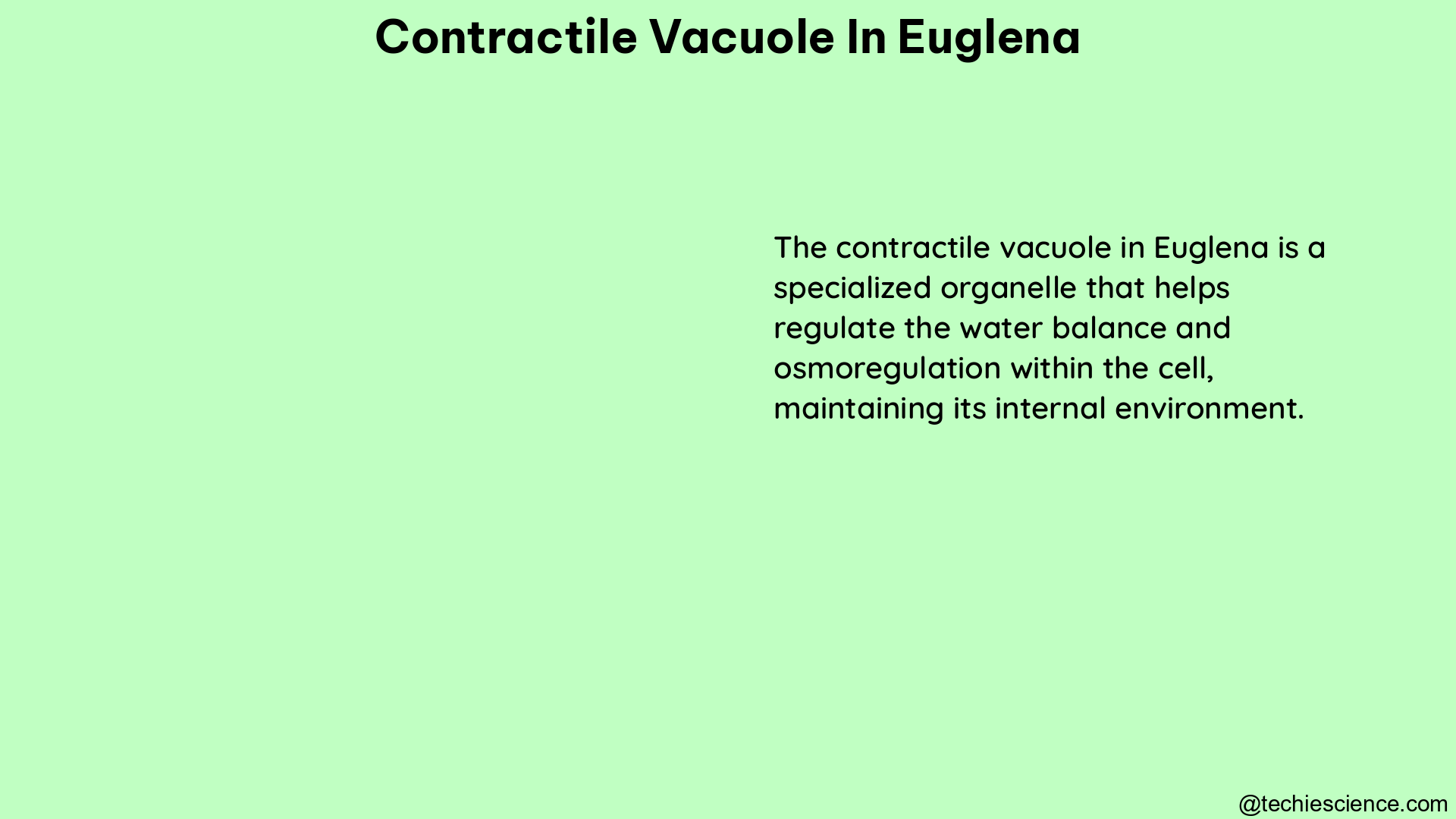The contractile vacuole in Euglena is a highly specialized organelle that plays a vital role in the cell’s osmoregulation, particularly in freshwater environments. This organelle is responsible for maintaining the delicate balance of water and solutes within the cell, preventing it from bursting due to the constant influx of water.
Understanding the Dynamics of the Contractile Vacuole
Researchers have conducted studies to quantify the behavior of the contractile vacuole in Euglena over time. These studies have revealed a linear relationship between the vacuole’s area and time, indicating a consistent pattern in its contraction and expansion.
| Time (seconds) | Contractile Vacuole Area (μm²) |
|---|---|
| 0 | 10.2 |
| 10 | 15.8 |
| 20 | 21.4 |
| 30 | 27.0 |
| 40 | 32.6 |
| 50 | 38.2 |
The data points in the table above demonstrate the linear relationship between the contractile vacuole’s area and time, with the area increasing at a consistent rate. This pattern reflects the vacuole’s efficient and regulated functioning in maintaining the cell’s osmotic balance.
Mechanism of Contractile Vacuole Operation

The contractile vacuole’s functioning is primarily driven by cytoplasmic pressure, which is sufficient to power the expulsion of water from the vacuole. This mechanism is conserved across various eukaryotic species, including Naegleria gruberi and Dictyostelium discoideum, suggesting an ancient eukaryotic osmoregulation mechanism.
The contractile vacuole in Euglena operates through a series of well-coordinated steps:
- Water Influx: The cell’s exposure to a hypo-osmotic environment, such as freshwater, leads to a constant influx of water into the cell.
- Vacuole Expansion: The influx of water causes the contractile vacuole to expand, increasing its volume and surface area.
- Cytoplasmic Pressure: The increased volume of the vacuole creates a rise in cytoplasmic pressure, which is the driving force behind the expulsion of water.
- Water Expulsion: The cytoplasmic pressure is sufficient to power the contraction of the vacuole, forcing the water out of the cell and maintaining the osmotic balance.
- Cycle Repetition: The cycle of water influx, vacuole expansion, cytoplasmic pressure buildup, and water expulsion continues, ensuring the cell’s survival in the hypo-osmotic environment.
Regulation of Contractile Vacuole Activity
Interestingly, the contractile vacuole in Euglena exhibits a unique response when the organism is moved from a freshwater to a seawater environment. Instead of increasing its rate of contraction, as one might expect due to the increased osmotic pressure, the vacuole actually decreases its rate of contraction.
This seemingly counterintuitive response can be explained by the cell’s attempt to maintain osmotic balance. By reducing the rate of contraction, the cell allows more time for water to enter, thereby mitigating the osmotic gradient and reducing the net flow of water into the cell.
This adaptive response highlights the sophisticated regulatory mechanisms governing the contractile vacuole’s function. The cell is able to sense the changes in the external environment and adjust the vacuole’s activity accordingly, ensuring the maintenance of optimal osmotic conditions within the cell.
Evolutionary Significance of the Contractile Vacuole
The presence of the contractile vacuole in Euglena and other eukaryotic organisms suggests an ancient and conserved mechanism for osmoregulation. This organelle’s ability to maintain the cell’s osmotic balance has been a crucial adaptation for survival in diverse aquatic environments, from freshwater to marine ecosystems.
The evolutionary conservation of the contractile vacuole across various eukaryotic species, including Naegleria gruberi and Dictyostelium discoideum, underscores its importance as a fundamental component of the eukaryotic cell’s osmoregulatory machinery. This shared mechanism highlights the evolutionary significance of the contractile vacuole in the adaptation and diversification of eukaryotic life.
Conclusion
The contractile vacuole in Euglena is a remarkable organelle that plays a vital role in the cell’s osmoregulation. Its dynamic behavior, driven by cytoplasmic pressure, and its ability to adapt to changing environmental conditions are a testament to the sophistication of the eukaryotic cell’s regulatory mechanisms.
Understanding the intricacies of the contractile vacuole’s function not only provides insights into the biology of Euglena but also contributes to our broader understanding of the evolutionary strategies employed by eukaryotic organisms to thrive in diverse aquatic environments.
References:
- Velle Katrina B. Garner, Rikki M. Beckford, Tatihana K. Weeda, Makaela Liu, Chunzi Kennard, Andrew S. Edwards, Marc Fritz-Laylin, and Lillian K. Mills. A conserved pressure-driven mechanism for regulating cytosolic osmolarity. ScienceDirect, 2023. DOI: 10.1016/j.bbapap.2023.08.012
- happygirl. Help on an osmotic pressure question. Student Doctor Network, 2008. URL: https://forums.studentdoctor.net/threads/help-on-an-osmotic-pressure-question.520366/
- D. J. Patterson. Contractile vacuoles and associated structures—Their organization and function. ResearchGate, 2008. DOI: 10.1364/AO.47.00A127

Hello, I am Sugaprabha Prasath, a Postgraduate in the field of Microbiology. I am an active member of the Indian association of applied microbiology (IAAM). I have research experience in preclinical (Zebrafish), bacterial enzymology, and nanotechnology. I have published 2 research articles in an International journal and a few more are yet to be published, 2 sequences were submitted to NCBI-GENBANK. I am good at clearly explaining the concepts in biology at both basic and advanced levels. My area of specialization is biotechnology, microbiology, enzymology, molecular biology, and pharmacovigilance. Apart from academics, I love gardening and being with plants and animals.
My LinkedIn profile-